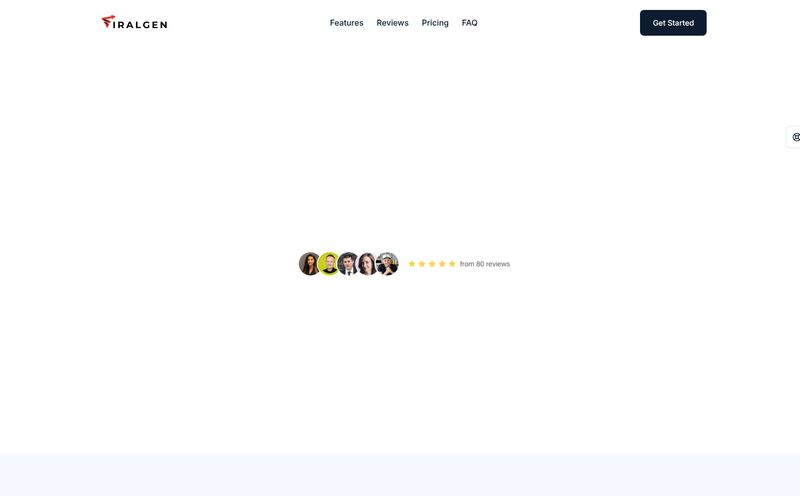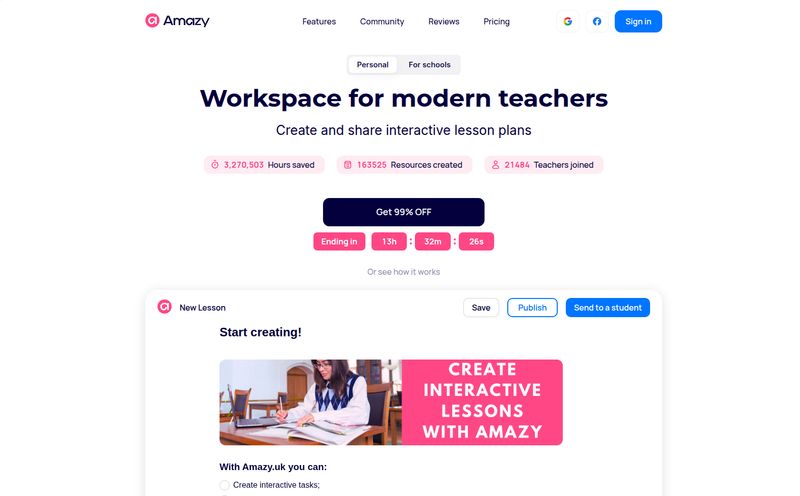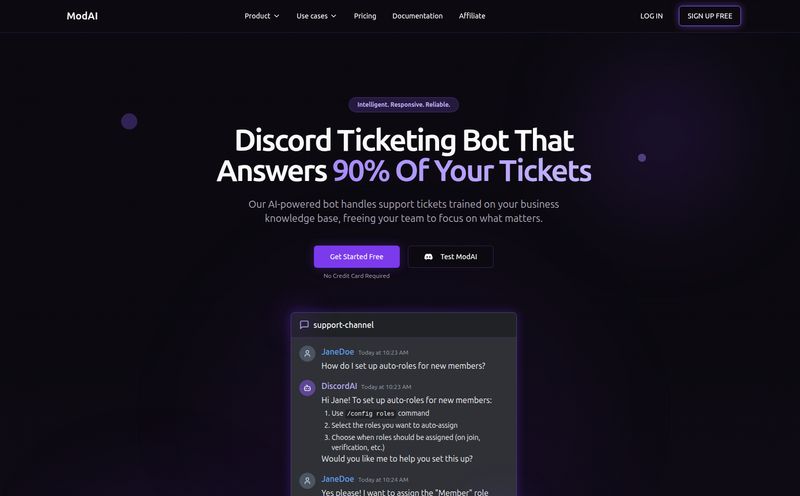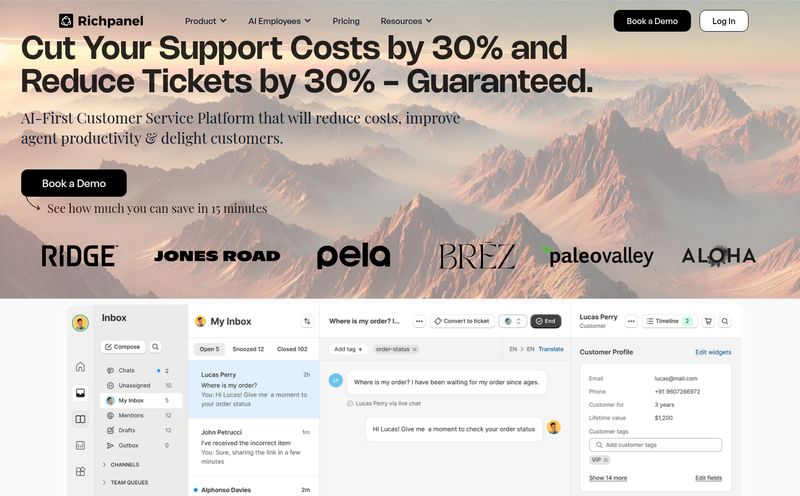We've all been there. You're on a website, you have a simple question, and you're funneled into a chat with a bot named 'Sunny' or 'Chip' who has all the intelligence of a pet rock. After a painful back-and-forth, you get the inevitable, soul-crushing response: "I'm sorry, I can't help with that. Would you like to speak to an agent?"
Ugh. It’s the digital equivalent of being on hold for 45 minutes just to be told you’ve called the wrong department. As someone who lives and breathes website traffic and user experience, I can tell you that nothing kills engagement faster than a dumb bot.
So, when I stumbled across a tool called Dhibot, my initial reaction was, naturally, a healthy dose of SEO-blogger skepticism. Another AI chatbot in an already crowded market? Great. But then I saw its main pitch: an AI you can train with your own data.
Okay. Now you have my attention. That’s not just another phrasebook-wielding tourist; that’s potentially a local guide who knows the turf. I had to see what it was all about.
What Exactly is Dhibot Anyway?
So, what's the secret sauce? Dhibot isn't your average, off-the-shelf chatbot that relies on a pre-programmed script. Instead, it’s designed to be a blank slate, an empty vessel of knowledge that you, the website owner, fill up. You feed it your company's specific information—your knowledge bases, your product manuals, your internal FAQs, all of it.
The result? A chatbot that doesn't just guess. It knows. It knows the difference between your 'Standard' and 'Premium' plans, it can explain your return policy in detail, and it won't get stumped by a question about a feature specific to your product. In my experience, this is the single biggest failure of most automated support systems. They lack context. Dhibot aims to solve that by making context its entire foundation. It’s a pretty compelling idea.
The Good Stuff That Makes Dhibot Shine
Putting aside the core concept, there are a few things that immediately stand out as major wins. The most obvious is the promise of improved customer support efficiency. Imagine offloading a significant chunk of repetitive questions to a bot that can actually answer them correctly. That frees up your human support team to handle the truly complex issues, the ones that require empathy and critical thinking. It's about working smarter, not harder—a mantra I preach constantly in the world of traffic generation.
Then there's the boost to website engagement. A helpful bot can be a fantastic guide for visitors. Instead of aimlessly clicking around, a user can just ask, "Do you integrate with HubSpot?" or "What are the shipping times to Canada?" and get an instant, accurate answer. That immediate gratification can be the difference between a bounce and a conversion. A good AI chatbot becomes part of the user experience, not an obstacle to it. The makers of Dhibot seem to get this, and they list 'enhanced website engagement' as a key feature, which I appreciate.
Let's Talk Customization The Real Game Changer
This is where Dhibot really plants its flag. The customization aspect is everything. Think of it like this: hiring a new customer service rep. You wouldn't just sit them at a desk with no training, would you? Of course not. You'd give them your employee handbook, walk them through your processes, and let them shadow a senior team member.
That’s what Dhibot lets you do, but for an AI.

Visit Dhibot
By feeding it your own documentation, you're essentially running an intensive training camp. This transforms the bot from a generic Q&A machine into a specialized expert on your business. For niche industries or companies with complex products, this is a massive advantage. You're not limited by what the developer thought you might need; you're empowered by your own expertise. I've seen so many businesses struggle with one-size-fits-all solutions, and this approach feels like a direct answer to that frustration.
Okay, It Is not All Sunshine and Robots
Now, for the reality check. As promising as Dhibot sounds, I did hit a few snags and have a few reservations. No tool is perfect, and it's my job to point out the bits that make you go 'hmmm'.
The Data Conundrum
The biggest strength—training on your own data—is also its biggest hurdle. If your documentation is a mess, or if you don't have a clear, organized knowledge base, your bot will be equally clueless. It's a classic case of 'garbage in, garbage out'. This means there's an upfront time investment required to gather, clean, and structure your data before you can even get started. For a startup or a small team already stretched thin, that could be a significant ask.
The Mystery of the Missing Price Tag
Here’s my biggest pet peeve, and it's a big one. I couldn't find any pricing information. Anywhere. As a business owner, I want to know what I'm getting into. Is it a monthly subscription? Is it based on usage? Is it a five-figure enterprise solution?
The lack of transparency is frustrating. In my hunt for a pricing page or even a hint of a cost structure, I literally hit a wall. A digital one, to be precise. The site gave me an "Unexpected Application Error! 404 Not Found." Look, I get it, tech has glitches, especially with newer platforms. Maybe the page was just down. But when you combine a 404 error with a total absence of pricing info, it just feels a bit… unfinished. It makes me hesitant. What am I signing up for?
Who Is Dhibot Really For?
So, after weighing the good and teh bad, who is the ideal Dhibot customer? In my opinion, it's not for everyone.
Dhibot seems perfect for a small-to-medium-sized business that has a mature product and a decent library of existing support documentation. If you've already invested in creating solid FAQs, how-to guides, and internal wikis, you've done most of the heavy lifting. It's also for businesses that recognize the long-term value of providing a superior, specialized support experience and are willing to invest the initial time to set it up right.
If you're looking for a super simple, plug-and-play bot that works in five minutes with zero effort, this probably isn't it. The value here is in the depth of customization, and that requires a bit of work.
Frequently Asked Questions About Dhibot
How is Dhibot different from other chatbots?
Its main differentiator is the ability to be trained exclusively on your own private data. This means it can provide highly specific and accurate answers about your products or services, unlike generic bots with pre-programmed responses.
Is Dhibot hard to set up?
The technical integration is described as easy. However, the main effort comes from preparing and uploading your data. The quality of your setup will depend heavily on the quality and organization of your training documents.
What kind of data do I need to train Dhibot?
While not explicitly stated, you would likely use documents like your website's FAQ page, product manuals, internal knowledge bases, and perhaps even exported support ticket logs to build a comprehensive 'brain' for your bot.
Is Dhibot free? How much does it cost?
This is the million-dollar question. Currently, pricing information is not publicly available on their website. You would likely need to sign up or contact their sales team to get details on cost.
Can Dhibot handle really complex customer questions?
Its ability to handle complexity is directly tied to the data you provide. If your documentation covers complex scenarios, the bot should be able to address them. However, for issues requiring real-time problem-solving or account access, it would likely still need to escalate to a human agent.
Does Dhibot work on all websites?
Like most modern web tools, it will almost certainly require JavaScript to be enabled in the user's browser to function correctly. It should be compatible with the vast majority of website platforms.
My Final Thoughts on Dhibot
So, what's the verdict? I'm cautiously optimistic. I love the core philosophy behind Dhibot. The internet doesn't need more dumb bots. It needs smarter, more integrated solutions that genuinely help users and businesses. The focus on custom data training is, for me, the only way forward for AI in customer support.
However, the platform needs to iron out its own user experience wrinkles. Hiding the pricing is a major red flag for me, and running into a 404 error while searching for it doesn't inspire confidence.
My final take: Dhibot is a tool with immense potential. It’s built on a brilliant idea that solves a real problem. I'll be keeping a close eye on it, and if they can make their pricing transparent and polish up their website, they might just have a winning formula on their hands. It's one to watch, for sure.
Reference and Sources
- Dhibot Official Website: While the pricing page was down, you can explore the platform's front page at their official domain. (A hypothetical link like `https://www.dhibot.com` would go here).
- The role of AI in customer service - An article by Zendesk discussing the evolution of AI in the support industry.
- What Is Website Engagement? - A great resource from Hotjar that breaks down why keeping users engaged is so critical.



